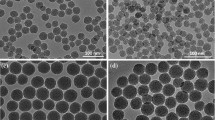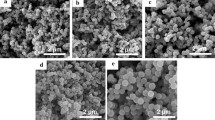Abstract
Ultrasmall silica colloid particles (SCPs) show broad applications in various fields, including cosmetics, paint, medicine, and electronics. However, the precise and scalable synthesis of ultrasmall SCPs remains challenging. This study introduces a facile polymer-based strategy for the synthesis of ultrasmall SCPs through the synergistic utilization of solvophobic interactions and electrostatic repulsion. The size of SCPs can be efficiently modulated by the ratio between solvophilic and solvophobic segments within random copolymers. This approach allows for producing SCPs with a diameter of down to 9.6 ± 1.7 nm and a solid content of up to 9.8%. Furthermore, amphiphilic SCPs were obtained by introducing PEO blocks into copolymer templates and modifying with long carbon chain silane coupling agent.




Similar content being viewed by others
Data availability
No datasets were generated or analyzed during the current study.
References
Ng S, Jelle BP, Sandberg LI, Gao T, Alex MS (2018) Hollow silica nanospheres as thermal insulation materials for construction: Impact of their morphologies as a function of synthesis pathways and starting materials. Constr Build Mater 166:72–80. https://doi.org/10.1016/j.conbuildmat.2018.01.054
Yang G, Wang Z, Du F, Jiang F, Yuan X, Ying JY (2023) Ultrasmall coinage metal nanoclusters as promising theranostic probes for biomedical applications. J Am Chem Soc 145(22):11879–11898. https://doi.org/10.1021/jacs.3c02880
Ernawati L, Ogi T, Balgis R, Okuyama K, Stucki M, Hess SC et al (2016) Hollow silica as an optically transparent and thermally insulating polymer additive. Langmuir 32(1):338–345. https://doi.org/10.1021/acs.langmuir.5b04063
Huang CC, Huang W, Yeh CS (2011) Shell-by-shell synthesis of multi-shelled mesoporous silica nanospheres for optical imaging and drug delivery. Biomaterials 32(2):556–564. https://doi.org/10.1016/j.biomaterials.2010.08.114
Kuwahara Y, Kango H, Yamashita H (2019) Pd nanoparticles and aminopolymers confined in hollow silica spheres as efficient and reusable heterogeneous catalysts for semihydrogenation of alkynes. ACS Catal 9(3):1993–2006. https://doi.org/10.1021/acscatal.8b04653
Kang M, Lee J-t, Bae JY (2023) Facile mesoporous hollow silica synthesis for formaldehyde adsorption. Int J Mol Sci 24(4):4208. https://doi.org/10.3390/ijms24044208
Liu X, Chen Y, Liu H, Liu Z (2017) SiO2@C hollow sphere anodes for lithium-ion batteries. J Mater Sci Technol 33(3):239–245. https://doi.org/10.1016/j.jmst.2016.07.021
Han Y, Lu Z, Teng Z, Liang J, Guo Z, Wang D et al (2017) Unraveling the growth mechanism of silica particles in the Stöber method: in situ seeded growth model. Langmuir 33(23):5879–5890. https://doi.org/10.1021/acs.langmuir.7b01140
Stöber W, Fink A, Bohn E (1968) Controlled growth of monodisperse silica spheres in the micron size range. J Colloid Interface Sci 26(1):62–69. https://doi.org/10.1016/0021-9797(68)90272-5
Bourebrab MA, Oben DT, Durand GG, Taylor PG, Bruce JI, Bassindale AR et al (2018) Influence of the initial chemical conditions on the rational design of silica particles. J Sol-Gel Sci Technol 88(2):430–441. https://doi.org/10.1007/s10971-018-4821-9
Lei X, Yu B, Cong H-L, Tian C, Wang Y-Z, Wang Q-B et al (2014) Synthesis of monodisperse silica microspheres by a modified Stöber method. Integr Ferroelectr 154(1):142–146. https://doi.org/10.1080/10584587.2014.904651
Ding HL, Zhang YX, Wang S, Xu JM, Xu SC, Li GH (2012) Fe3O4@SiO2 core/shell nanoparticles: the silica coating regulations with a single core for different core sizes and shell thicknesses. Chem Mater 24(23):4572–4580. https://doi.org/10.1021/cm302828d
Jin Y, Lohstreter S, Pierce DT, Parisien J, Wu M, Hall C III et al (2008) Silica nanoparticles with continuously tunable sizes: synthesis and size effects on cellular contrast imaging. Chem Mater 20(13):4411–4419. https://doi.org/10.1021/cm8007478
Wang L, Yang C, Tan W (2005) Dual-luminophore-doped silica nanoparticles for multiplexed signaling. Nano Lett 5(1):37–43. https://doi.org/10.1021/nl048417g
Van Helden AK, Jansen JW, Vrij A (1981) Preparation and characterization of spherical monodisperse silica dispersions in nonaqueous solvents. J Colloid Interface Sci 81(2):354–368. https://doi.org/10.1016/0021-9797(81)90417-3
Yang H, Wang L, Yuan B, Yang K, Ma Y (2015) Adhesion of an ultrasmall nanoparticle on a bilayer membrane is still size and shape dependent. J Mater Sci Technol 31(6):660–663. https://doi.org/10.1016/j.jmst.2014.09.012
Bedrov D, Smith GD, Davande H, Li L (2008) Passive transport of C60 fullerenes through a lipid membrane: a molecular dynamics simulation study. J Phys Chem B 112(7):2078–2084. https://doi.org/10.1021/jp075149c
Zhang X-D, Chen J, Luo Z, Wu D, Shen X, Song S-S et al (2014) Enhanced tumor accumulation of sub-2 nm gold nanoclusters for cancer radiation therapy. Adv Healthcare Mater 3(1):133–141. https://doi.org/10.1002/adhm.201300189
Amraee A, Alamzadeh Z, Irajirad R, Sarikhani A, Ghaznavi H, Ghadiri Harvani H et al (2023) Theranostic RGD@Fe3O4-Au/Gd NPs for the targeted radiotherapy and MR imaging of breast cancer. Cancer Nanotechnology 14(1):61. https://doi.org/10.1186/s12645-023-00214-6
Dadfar SM, Roemhild K, Drude NI, von Stillfried S, Knüchel R, Kiessling F et al (2019) Iron oxide nanoparticles: diagnostic, therapeutic and theranostic applications. Adv Drug Deliv Rev 138:302–325. https://doi.org/10.1016/j.addr.2019.01.005
Pandey S, Choudhary P, Gajbhiye V, Jadhav S, Bodas D (2023) In vivo imaging of prostate tumor-targeted folic acid conjugated quantum dots. Cancer Nanotechnol 14(1):30. https://doi.org/10.1186/s12645-023-00162-1
Wang F, He M, Huang B, Tang T, Liu F, Cui R et al (2023) Band gap engineering improves three-photon luminescence of quantum dots for deep brain imaging. Anal Chem 95(29):10947–10956. https://doi.org/10.1021/acs.analchem.3c00845
Li J, Pu K (2019) Development of organic semiconducting materials for deep-tissue optical imaging, phototherapy and photoactivation. Chem Soc Rev 48(1):38–71. https://doi.org/10.1039/C8CS00001H
He D-G, He X-X, Wang K-M, Zhao Y-X (2013) A facile route for shape-selective synthesis of silica nanostructures using poly-L-lysine as template. Chin Chem Lett 24(2):99–102. https://doi.org/10.1016/j.cclet.2013.01.038
Li W, Kuo C-H, Kanyo I, Thanneeru S, He J (2014) Synthesis and self-assembly of amphiphilic hybrid nano building blocks via self-collapse of polymer single chains. Macromolecules 47(17):5932–5941. https://doi.org/10.1021/ma501338s
Kind L, Plamper FA, Göbel R, Mantion A, Müller AHE, Pieles U et al (2009) Silsesquioxane/polyamine nanoparticle-templated formation of star- or raspberry-like silica nanoparticles. Langmuir 25(12):7109–7115. https://doi.org/10.1021/la900229n
Zhang Y, Yi C, Dong W, Zheng D, Yang Y, Li W et al (2022) Single copolymer chain-templated synthesis of ultrasmall symmetric and asymmetric silica-based nanoparticles. Adv Func Mater 32(20):2112742. https://doi.org/10.1002/adfm.202112742
Wu C-H, Jeng J-S, Chia J-L, Ding S (2011) Multi-nuclear liquid state NMR investigation of the effects of pH and addition of polyethyleneglycol on the long-term hydrolysis and condensation of tetraethoxysilane. J Colloid Interface Sci 353(1):124–130. https://doi.org/10.1016/j.jcis.2010.09.024
Hench LL, West JK (1990) The sol-gel process. Chem Rev 90(1):33–72. https://doi.org/10.1021/cr00099a003
Echeverría JC, Moriones P, Arzamendi G, Garrido JJ, Gil MJ, Cornejo A et al (2018) Kinetics of the acid-catalyzed hydrolysis of tetraethoxysilane (TEOS) by 29Si NMR spectroscopy and mathematical modeling. J Sol-Gel Sci Technol 86(2):316–328. https://doi.org/10.1007/s10971-018-4637-7
Cihlář J (1993) Hydrolysis and polycondensation of ethyl silicates. 1. Effect of pH and catalyst on the hydrolysis and polycondensation of tetraethoxysilane (TEOS). Colloids Surf A: Physicochem Eng Aspects 70(3):239–251. https://doi.org/10.1016/0927-7757(93)80298-S
Harris MT, Brunson RR, Byers CH (1990) The base-catalyzed hydrolysis and condensation reactions of dilute and concentrated TEOS solutions. J Non-Cryst Solids 121(1):397–403. https://doi.org/10.1016/0022-3093(90)90165-I
Liang X, Lian L, Liu Y, Kong Q, Wang L (2016) Controlled synthesis of monodisperse silica particles. Micro Nano Lett 11(9):532–534. https://doi.org/10.1049/mnl.2016.0189
Funding
This work is financially supported by the National Natural Science Foundation of China (grant 91963107, 52125308), the Innovation Program of Shanghai Municipal Education Commission (2021-01-07-00-07-E00073), the National Key R & D Program of China (2022YFA1404700), and the Shanghai Pujiang Program (23PJ1401000).
Author information
Authors and Affiliations
Contributions
This work was performed by Z. Q. Liu under the guidance of Y. T. Sang and Z. H. Nie.
Corresponding authors
Ethics declarations
Ethics approval and consent to participate
Not applicable.
Consent for publication
Not applicable.
Competing interests
The authors declare no competing interests.
Additional information
Publisher's Note
Springer Nature remains neutral with regard to jurisdictional claims in published maps and institutional affiliations.
Supplementary Information
Below is the link to the electronic supplementary material.
Rights and permissions
Springer Nature or its licensor (e.g. a society or other partner) holds exclusive rights to this article under a publishing agreement with the author(s) or other rightsholder(s); author self-archiving of the accepted manuscript version of this article is solely governed by the terms of such publishing agreement and applicable law.
About this article
Cite this article
Liu, Z., Zhang, Y., Sang, Y. et al. Scalable synthesis of ultrasmall hybrid silica colloidal particles through balanced solvophobic interaction and electrostatic repulsion. Colloid Polym Sci (2024). https://doi.org/10.1007/s00396-024-05258-7
Received:
Revised:
Accepted:
Published:
DOI: https://doi.org/10.1007/s00396-024-05258-7




